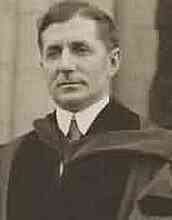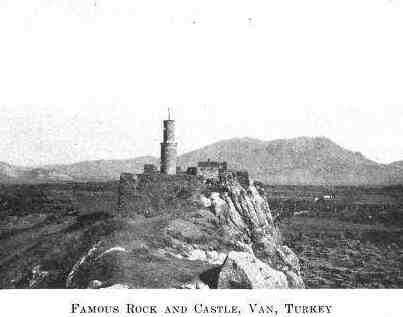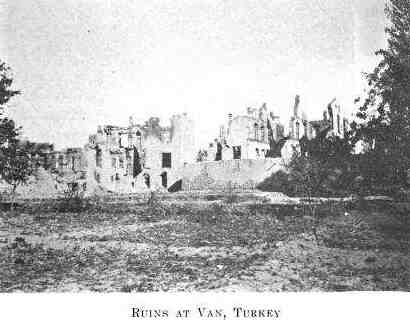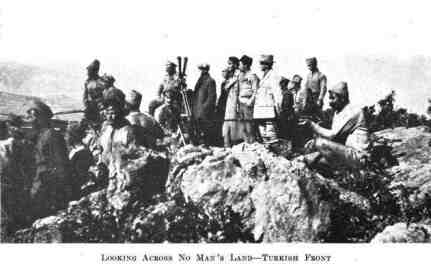|
|
The following book excerpt from "Russia After the
Revolution," Charles Ezra Beury, 1918, pp. 47-57, provides some
interesting details as to what both sides had to contend with.
Beury was an American eyewitness whose sympathies clearly did not belong with
the Turks, "inhuman" as they were, in his biased opinion. He
actually thought there were only one thousand Armenians in Van fighting 10,000
Turks, when even Henry Morgenthau was aware the Armenians numbered
10,000-25,000. (In an honest internal report; in his book, Morgenthau offered
the figure of 1,500.)
Regardless, Beury has some interesting notes, as when he encountered a
"pathetic" Turkish deserter, who was actually an Ottoman-Greek.
 |
|
Dr. Charles Ezra Beury |
Dr. Charles Ezra Beury, born 1879, graduated from
Princeton University in 1903, and went on to earn a law degree from Harvard in
1906. Before beginning his legal career, he devoted himself to travel. He
would go on to become the president of Temple University in 1926. A biography
of the man from
Philadelphia: A Story of Progress (1941) tells us:
"During the World War he served as director of the Victory Loan of
North Philadelphia and made trips to Russia for the Near East Relief and the
American Red Cross in 1917, 1918, and 1919, winning high commendation for the
work he accomplished in behalf of these organizations." Beury became
a trustee of the Near East Relief.
|
|
|
| |
From the "Overland to the Front in Turkey" Chapter:
The Governor of the Province of Van, Turkey, thoughtfully sent a mounted military escort
to protect us through the Kurdestan mountains on our long journey to the provincial
capital city of the same name. As we drove up through the valleys and over the passes and
plateaus, with our mounted guard conspicuously armed outflanking and galloping wildly
ahead of us to inspect the safety of each mountain pass, we remarked how much it must be
like crossing the prairies in '49. It was surely a picturesque cavalcade. The
velvet-colored mountain scenery was beautiful as we made our way up along the valley of
the Khotur River, constantly climbing. The changes of temperature were extreme — ice in
the morning, heat as of a tropic sun at midday. It took me back to a winter in India years
ago. At the Kurdish village of Khotur on the border between Persia and Turkey, we spent a
night in a little hut named by Dr. Ellis the "Hut of a Million Fleas" because of
our almost unbroken vigils in combating these little pests. It was just off a sheep's
cove, containing hundreds of sheep, goats, and cows, and from eight at night until four in
the morning, we silently struggled in an effort to go to sleep, but were finally compelled
to surround ourselves with a dike of insect powder before a few hours' rest was possible.
The Kurds are a wild, illiterate mountain people, only one in thousands being able to
read. They live largely by plundering, are Moslems, and have always taken advantage of
disturbances and political unrest to reap their harvests. The Armenian massacres have been
their especial opportunity. Now they are suffering in turn, for the Russian Army in its
sweep westward into Turkey had hunted them down, destroying their villages and taking
vengeance for past marauding. The land largely lay fallow because of the unsafe conditions
of the country, and it was noted how the few farmers whom we did pass were conspicuously
well-armed.
|
|
Reaching Van, we were the guests of the hospital of the Zuyuz Gardoff. This is one
of the nationwide volunteer organizations akin to our Red Cross, which has, in a
measure, supplied the deficiencies of the old Government in caring for the wounded
soldiers, providing the little comforts and conveniences which make soldier-life
endurable. The doctors and nurses were hospitality itself, and on the night before
we left arranged for an Armenian dinner in our honor as American Commissioners.
There were speeches in English, Armenian, Turkish, Russian, and Esperanto. The
speech in Esperanto was delivered by a Russian soldier who immediately acted as his
own interpreter as no other person in the audience could understand Esperanto, thus
illustrating the curious kinks of the Russian mind.
The city of Van, which is situated on a high plateau fifty-two hundred feet above
sea-level, stands out pre-eminently in the record of the present Armenian massacres.
Here a thousand volunteer Armenian militiamen held off ten thousand Turkish troops
for a period of twenty-eight days, protecting the city and the Armenian residents
from massacre until the arrival of the rescuing Russian Army. It was the only place
in which the Armenians had made a determined resistance against the inhuman Turks.
But to a certain extent their resistance was in vain, for five months later the
Russians, without proper reason, unexpectedly retreated and the populace found it
necessary to follow, taking with them only what they could conveniently carry or
transport in their limited number of carts and wagons. Since the Russians upon their
arrival had not spared the Turkish property in the city of Van, one could readily
imagine what the Mohammedans did to the Christian possessions upon the recapture of
the city. The premises of the American Mission, comprising schools, homes, a
hospital and an orphanage, were a maze of wrecked buildings. The church alone stood
practically intact and was being used by the Russian soldiers as their own. Mosques
everywhere had been desecrated. Wealthy Pasha homes and palaces were only blank
walls of brick. A city of fifty thousand inhabitants, wealthy, beautiful, and
prosperous, was in ruins.
|
| |
We had previously talked to many Armenians who had fought through this siege, and it was
saddening to learn that after the splendid resistance in the early months of the
massacres, seventy thousand Christians, fleeing to Russian territory, perished of
starvation and disease. Subsequently the Russian forces returned to Van, followed in their
wake by thousands of refugees, but hardly had they been re-established on their own land,
through the splendid aid of the Armenian Relief Committee, when another retreat followed a
threatened retirement by the Russians, and the work of reconstruction was dissipated. And
yet we found that in the Fall of 1917 many of the people had again come back, probably
only to go through still another disastrous exodus unless the Armenian soldiers could hold
off the Turks when the Russians left this front.
General Seileekoff, divisional commander of the Russian forces, planned and arranged for
our journey to and along the front in Turkey, and detailed as our escort a splendid,
English speaking officer, a graduate of Moscow University. We crossed Lake Van practically
as deck passengers, the boat, armed fore and aft, being within range of the Turkish guns
during part of the sixteen-hour journey to Garmooch on the western shore.

FAMOUS ROCK AND CASTLE, VAN, TURKEY
Here our host was that famous officer of the Russian Army, General Nazarbekoff, who a year
and a half before, in the dead of winter, had taken his army down through the mountains of
Kurdestan to the plain of Moosh and captured Bitlis, to the wonderment of military critics
both in Europe and America. He told us the story of that expedition, and said that as they
crossed the frozen streams troopers on their horses frequently broke through, and their
comrades could see their dead bodies coming out in the rapids below. Their lines of
communication were severed, but they kept pressing on over the snow and ice-covered passes
until they established the outposts which made possible the further advance of the British
Mesopotamian Army. Undoubtedly the army would now be beyond Bitlis and in close
co-operation with the British General Marshal, if the Revolution had not destroyed the
fighting spirit of these forces. This strong man was a pathetic figure, for military
discipline was so far lost among the Russian troops that many of the simplest commands
were not obeyed, and he was neither able to retire nor resign. General Nazarbekoff, for
his wonderful feat, had been decorated by the French Government. He was very proud of the
medal and said he had hoped some day to go to Paris and wear it on his breast, but since
the Russian Army had failed, he did not feel that he would any longer be welcomed.

RUINS AT VAN, TURKEY
|
|
In several places we visited the Turkish front and found the soldiers storing wood
and preparing for the bitter cold of winter. For the most part they lived in dugouts
made of dirt, stone, and brush. Some of these were almost totally underground and
had the double advantage of warmth in winter and coolness in summer. The Caucasus
Army has employed the Mongolian huts or tents extensively, bringing them from
Turkestan. A round frame base of wood with conical top is covered with heavy
decorated felt instead of canvas. General Wachnadze, of the Sixth Caucasian
Regiment, a Georgian prince, was especially courteous to us. With his staff he took
us to the front so that we could clearly see the Turkish soldiers across the line.
We also enjoyed a holiday excursion as his guests, going to the top of Mount Nimrod,
an extinct volcano containing the largest volcanic lake in the world, its diameter
being about three miles.
The soldiers along this front were holding on tenaciously, not because of the
Turkish attacks, for the Turks were apparently in a very bad way for want of food,
judging from the great numbers of deserters who came over daily, but because of the
scarcity of food supplies and the fear that it would be necessary to fall back on
their lines of communication. In the past many soldiers had been caught in a cul
de sac along this front and had died of starvation, and we found that most
regiments were suffering from limited rations. The morale of this army was
probably better than that of any other in Russia, but it was distinctly undermined
by the lack of transportation and the consequent food shortage. This front was, on
an average, at least a week's journey from the nearest rail-head. Nature and the
pacific attitude of the Russian troops, not Turkish resistance, blocked the way to a
successful offensive.
When we asked the Russians at the front why they did not shoot, they said,
"What's the use? If we fire, the Turks simply fire back; someone is likely to
be hurt and nothing is gained." Class distinction between officers and men had
broken down. We noted that when private soldiers came in they merely joined the
group in free, democratic conversation. The soldiers' committees passed on any
action and no important movement was possible without their consent.
Warfare on this front was not the modern trench warfare of France, but the
old-fashioned kind, in which details and divisions of troops held passes and high
roads and strategic points. There were trenches, of course, but the equipment and
housing arrangement of the soldiers were all of a mobile nature, so that they might
be moved at any time from one position to another.
I have spoken of the Turkish deserters. One particularly pathetic deserter from the
Turkish army was a Greek from Smyrna. He said that during the first two years of the
war he had twice paid the cost of exemption from the Turkish army, but that in spite
of his payments, they had unjustly forced him into the service.
In our days of journeying from the Turkish front, even better opportunities than we
had heretofore experienced were afforded us for measuring the devastation of this
region. Over a war-zone six hundred miles long from Trebizond, Turkey, to Ramadan,
Persia, and from one hundred to three hundred miles wide, the advancing and
retreating armies — Christian and Moslem — had beaten back and forth, laying
waste practically every village, town, and city. Four times we crossed, transversely
and longitudinally, major portions of this area, and can report thousands of square
miles of the oldest known portions of the world's surface denuded of every
inhabitant except those engaged in military service. We have seen literally hundreds
of towns destroyed and lifeless. It was worse than Belgium or France, for the people
had all been killed or driven absolutely away. Over this whole district farms were
lying fallow during a period of unprecedented world famine. No foodstuffs were being
raised in this most fertile region, nor any cattle. The surviving inhabitants were
crowded into seemingly safe territory outside the war devastated zone and had become
the uninvited and unwelcome guests of the native peoples.
Part of this trip was made in Red Cross carts and army wagons. The Red Cross carts
nominally have springs, but it would be hard to conceive of anything more
uncomfortable. Even sitting on the seat, we found the jarring of these two-wheeled
vehicles a severe trial. What must it have been for the wounded men who were forced
to endure it for days, lying flat in the body of the cart! In fact, ordinary army
wagons or fergons without any springs, which we later traveled and slept in,
did not seem much worse. We found Mongolian coolies working on the railroads that
were being built to the front, just as thousands of them are working behind the
British and French lines in France — on the railroads and in the fields. The
Russians had built hundreds of miles of auto road which were nearly completed, but
they had finished no part of it so that it could be used. Part of this high-road
skirted the banks of the famous Euphrates, which here runs west by south before
making a semi-circle into the Mesopotamian plain.
|

LOOKING ACROSS NO MAN'S LAND — TURKISH FRONT |
At Kara Kalissa we again reached the railroad and were immediately taken to the
Commandant, a fine forward-looking Cossack. We had tea and dinner as his guests and
learned much at first-hand concerning the esprit de corps of these world-renowned
fighting men. There are twelve divisions of Cossacks which hold their land by right of
military tenure. The land is worked on a community basis and most of the Cossacks are
comfortably well-to-do. It has been one of their principles to keep out of politics though
supporting the ruling government, and previous to the Revolution, they were always loyal
to the Czars. In consequence they were greatly feared by the people because of their
ruthless, iron allegiance to the Crown. But with the coming of the Revolution their
loyalty shifted to the people's side. The long-flowing coat, heretofore characteristic of
the Cossacks, has been dispensed with except among certain classes, such as the Caucasian
Cossack with his Circassian costume, and most of these men now fight on foot, whereas
before this war they were practically all mounted. Modern trench warfare has brought this
change about.
The return trip which almost encircled the base of Mount Ararat, disclosing its every
side, again demonstrated the contrasting degrees of comfort which we experienced. From the
rough-going army wagon we changed to a private car provided by General Nazarbekoff at the
rail-head, and for thirty hours our party of five enjoyed a period of real luxury. This
was quickly interrupted, however, at the junction station of Shactacti, where, through a
miscalculation — a most common occurrence in Russia — we found it necessary, after
midnight, to seek a place on the Tiflis train. In going through the train to the
compartment where I knew Mr. McDowell to be, I found him with fourteen Persian and Syrian
companions in a four-berth compartment, and despite the overcrowding approaching
congestion, they hospitably asked us to join them! This condition had to be endured not
for a few hours but for a journey covering three nights and days on a composite train of
coaches, military and freight cars.
At Tiflis, after gladly saying good-bye to some but not all of our unwelcome parasitic
friends through the medium of hot sulphur baths, and reluctantly parting from a number of
the rare real companions who had made our journey pleasant and , never to be forgotten,
Mr. McDowell and I started on a five-day trip by rail back to Petrograd. We again called
on our friend Monsieur George to secure us a compartment, and instead of a berth each —
the berths are narrow and run across the car — Mr. McDowell and I had to double up in
the lower berth, my feet beside his head and vice versa, a young woman with her child
occupying the upper berth of the compartment. This situation, which would be rather
startling in America, is very common in Russia. where travelers are constantly being
forced into embarrassing positions by a widespread disregard for the sexes which is part
and parcel of unmoral Russia.
|
|